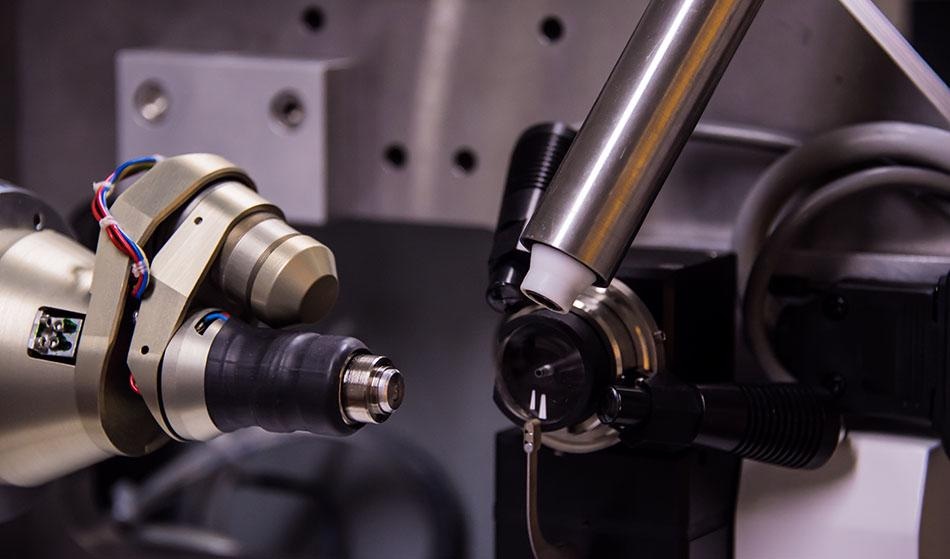
Gianmix / Shutterstock
Diffractometers have been around for a long time and are used to analyze various types of materials and provide information regarding their structure. While there are a few different types, we’re going to focus on the two most common types, which are X-ray diffraction (XRD) and neutron diffraction, which analyze how a sample scatters X-rays and neutrons, respectively.
X-Ray Diffraction (XRD)
XRD uses monochromatic X-rays to investigate the structure of a sample. It is a non-destructive technique that is used on crystalline structures due to their regular and repeating crystal lattices and offers a way of analyzing the composition and structural arrangement of the crystal, the atomic spacing between atoms in a sample, as well as providing insights into how the sample might behave in certain environments. In terms of applications, XRD is commonplace in almost any scientific industry, whether it is for analyzing pharmaceutical drug samples and how they’ll behave, for analyzing the structure of minerals and geological samples, for investigating the degree of crystallinity in polymers, and in forensic labs for analyzing crystalline materials present in the textiles found at crime scenes. These are just a few examples of the applications, as it is now a mainstream and ubiquitous technique, and is therefore impossible to document every single application.
XRD works on the principles of elastic scattering and uses monochromatic X-rays to analyze a sample. X-rays are initially generated from an X-ray source (often a cathode tube) before being filtered through a monochromator to produce X-rays of a single wavelength frequency. These are known as monochromatic X-rays. The X-rays are then concentrated and fired at the sample, where they are refracted by the atoms and detected by the detector.
How the X-rays interact with the sample is key to how XRD works. XRD works because the incident X-rays produce a constructive interference that satisfies Braggs law. Braggs law is when an atom can scatter electromagnetic waves, but this scattering is dependent upon both the diffraction angle and the atomic spacing within the material. In XRD, the sample is scanned through an angle which is twice the size of the scattering angle and this enables the diffraction pattern to be observed because the refracted X-rays have the same energy as the incident waves (elastic scattering) and because the material is randomly orientated.
How each atom in the sample refracts the X-rays enables the structure of the sample to be determined. This is because each element scatters the X-rays differently, and this provides key indicators as to the elemental composition of each atom, which enables a picture to be built up of the sample. If the sample is scanned from one direction only, it generates a 2D diffraction pattern, but in some cases, the sample can be on a goniometer and be analyzed in multiple directions—this is known as X-ray crystallography (XRC). Analyzing the sample in multiple directions enables a 3D representation of the sample to be generated. In either case, the diffraction patterns are compared against known references to deduce the sample being analyzed.
Neutron Diffraction
Neutron diffraction, also known as neutron scattering, can analyze sample in two different ways because the neutrons which are fired at the sample have an intrinsic magnetic moment that can interact with the sample—and the magnetic moment interacts differently with the atoms because the atoms in the sample all have different alignments depending on their magnetic moments. In terms of applications, neutron diffraction can be used to study a wide range of substances including crystalline materials, amorphous materials, liquids, and gases. It is, therefore, more versatile in the materials it can be used with compared to XRD and is often used to analyze bulk samples. It is also used on crystalline samples alongside XRD to provide complementary data regarding the crystallographic structure, so there are several cross-over applications with XRD.
Neutron diffraction is like XRD in that neutrons are fired at the sample instead of X-rays and the scattering of the neutron is used to determine the elemental composition of the sample. However, where X-rays typically interact with the electron cloud that surrounds the nucleus of the atom, the neutrons which are directed towards the sample interact directly with the nucleus. The diffraction of neutrons is often used to study different isotopes in a sample because the degree of diffraction is different for each elemental isotope as well as different elements. A lot of experiments are done at ultra-low temperatures as the diffraction of the neutrons is more defined, and liquid cooling systems are often used which enables data to be collected down to 4.2 K. The diffraction of the neutrons gives precise values for the position of each atom.
The magnetic variation of neutron diffraction works differently to nuclear diffraction in that they don’t interact with the nucleus. Even though neutrons possess a neutral charge, they still have a spin (which generates an internal moment) and can interact with the electron cloud around the nucleus via their magnetic moments. This variation is often used to determine the microscopic magnetic structure of a material, but it is not as effective at high scattering angles.
Sources
Disclaimer: The views expressed here are those of the author expressed in their private capacity and do not necessarily represent the views of AZoM.com Limited T/A AZoNetwork the owner and operator of this website. This disclaimer forms part of the Terms and conditions of use of this website.